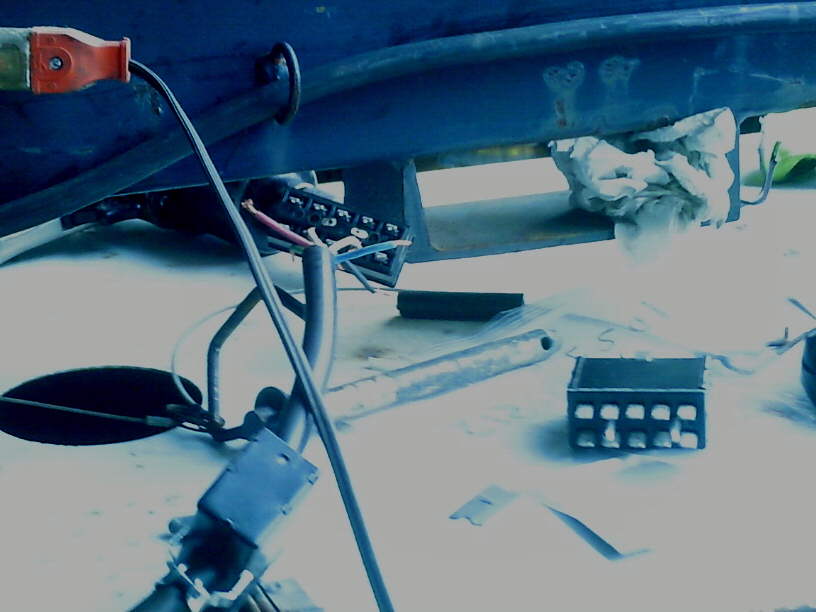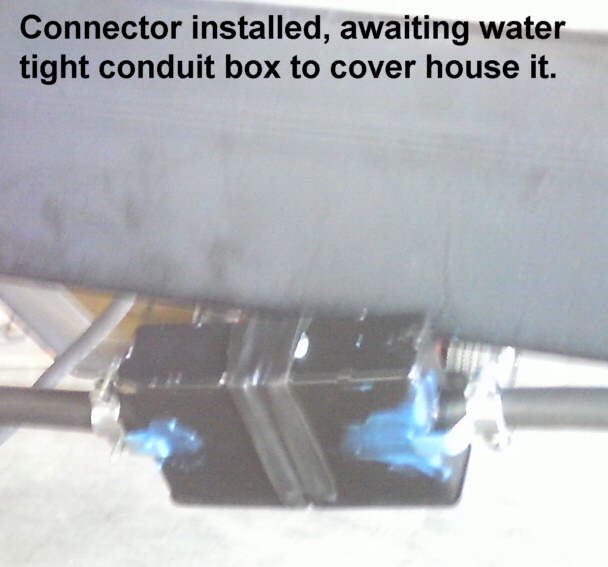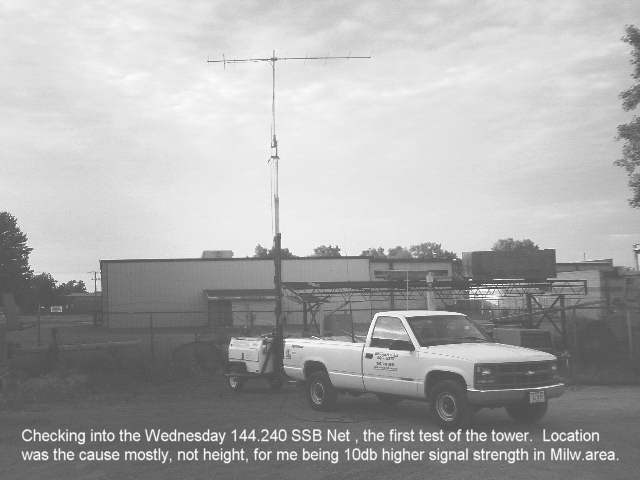|
A PORTABLE VHF TOWER by Dave,WV9E
I live in a VHF black hole, some say at the singularity in the center,where not even 2 meters can
escape, the Mississippi River Valley at EN43jv Onalaska, WI. Having operated VHF from both the valley floor and various
local ridge tops it is clear that elevation equals gain. This is painfully obvious on VHF and above.
Since I live on the floor of the valley and it's not likely I would
be living on a ridge any time soon I wanted a way to have a decent home like operation while portable
on the ridges or anywhere else I choose go portable on VHF+.
DISCOVERY
A decent portable tower,should carry a generator, and have home station like height if possible. After a time,
it dawned on me that a portable light tower would be a solution, if an affordable one could be found.
I ran across this Wacker light tower with it's 4 - 1000w hp-sodium lamps included at the top of the mast
(see graphic below). It should easily handle my VHF stack of yagis 50-1296 considering the weight of the lights
it already can hold up 30 feet and likely an HF beam alone if wanted it to sometimes. Another benefit of this unit is
that it has an on-board 4-pole(1800 rpm makes 60hz) 6 kw generator,diesel powered,with a 40 hour run time
on a single tank of fuel at near full output. With outriggers and a crank-up mast,towable by any 1/2 ton
class vehicle how could a ham resist? Some haggling and it was mine.
GETTING IT READY FOR USE
Now,some method to remove the lamps,unhook the lamp cords, mount the antennas and do it easily in
reverse as well to have a functioning light tower. A simple change out from lamp to antenna and back, plug n play.
Since this light plant did not have factory installed electrical connectors for the lamps, some brands do,
this was going to be the hardest problem. The rest seemed easy enough.
A small engine hoist to pick the lamps off in one peice on their mount bar ok, I had a hoist.
The 2, 5/8in bolts used to fasten the light bar could be used for the antenna rotor bracket mount,
a simple angle iron with a 1-1/2in pipe welded on astride holes for the bolts easy enough from the
scap bin,I have a welder(see illustration below for design). Now a waterproof connector for splitting the lamp cord in the best spot,
the 8-wire main cord, then be able to re-hook them easily with no idea what to use
for a connector. I finally settled on a 12 pin that uses large
spade style connectors. I would enclose them in a water proof junction box, the connectors are about 4 X 1 inches,
these I found through a machine manufacturer as I use them here and there for work, but they are simply a cynch
jones type that can be found at various web stores. I haven't been able to verify their actual AC voltage handling
capacity so you use them at your own risk, but after a 4 hour test of the lamps there was no sign of any
dis-coloration or heating, they looked absolutely new. Actually those bulbs only need about an amp AC, so
I am figuring it's fine. At any rate this turned out to be fortunate as other brand light plants use 4
seperate connectors, easier to change out one whole lamp ass'y, but time consuming for my purpose. Also
those other brands leave a large junction-connector box at the top with the 30 ft. coiled main cord hanging
down loosely about the mast, potentially a tangle mess for coax when used as an antenna mast.
FIRST LARGE SCALE USE A SUCCESS
The setup shown for 2013 FD worked great. A simple TV rotor is enough to turn
it(can run off a 12v w/300w inverter) It stood up to the winds we had during storms that shut us down for several hours. We made several
ground wave contacts on 6 proving a good low take off angle there. We were the loudest on satellite, when F0-29
was low to our horizon, enough to "run" a downlink frequency for 3 Q's on SSB. Shortly before the end of our
operating time 1300 local, we were able to work FG5GP first call on 6. First full scale deployement also
demonstrated the ease of set up by one person if necessary,(field day is a group activity for us so everyone
pitched in). Take down was the same, easy as toast.
CONCLUSION
While not as easy to set up as a traditional rover vehicle, it isn't really designed for that, considering
the set up area needed and time spent assembling/disassembling antennas. However for a grid activation
towed behind a RV or truck camper it's a good solution. Plenty of extra A/C to camp with too.
More uses? Back up power for house or public service need in cases of emergency(40hr run time), as a
portable repeater for ARES/public service use,keep one or all the lights on, set up temperary jobsite or
disaster lighting or video monitoring . That's the short list. I am sure this is not an original idea ,
but I haven't seen it anywhere else so this may fuel the imaginations of other hams.
Be prepared to fork out a couple grand for a functional older one, up to 6-7,000 for a new one. Finding
them is rather easy as they are all over in rental equipment yards. A web search may turn up hundreds
in your area/region.




|
FIRST SETUP W/ ALL 6 BANDS
FIELD DAY 2013 with the
Mississippi Valley Amateur Radio Association.
Photo courtesy of Bill, N9FDE

(above)Onalaska WI parking ramp Gunderson clinic
(below)My shop parking lot, first test, 2 meters, I
was S9 in EN63, Wednesday 144.240 net near Milwaukee.

I hold an Extra class license. I operate the bands
anywhere from 160 to .23, phone mostly,depending
on how I am suffering from ham-sickness(kid in a
candy store syndrome)on a given day.
Dave at wv9e d0t net.
|





